

 |
| Number 42, October 2002 |
 |
 Suite for science
Suite for science
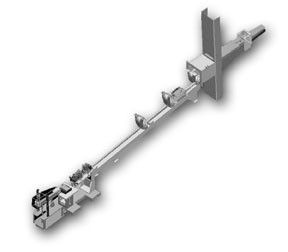 |
| The Liquids Reflectometer is one of a collection of instruments that will give neutron scientists unmatched abilities to analyze molecular structures. |
The Spallation Neutron Source, now under construction atop Chestnut Ridge, will one day offer 10 times more neutrons per second per unit area than any comparable source available today. The SNS’s beam intensity—an unparalleled resource for materials scientists around the world—is one reason the neutron science community is counting the days until its scheduled 2006 completion.
The big payoff for scientists, however, will come with the arrival of those neutrons at a new suite of state-of-the-art instruments. In some instances, thanks to its instruments, the SNS will be factors of thousands better than any neutron research facility currently available. The high intensity of neutron beams is important, says Kent Crawford, because it will allow the researchers more flexibility with their analytical tools.
“We can trade off that intensity for higher resolution, so the more intensity you have, the higher resolution you can attain,” says Kent, an Argonne National Laboratory researcher assigned to the SNS project’s Experimental Facilities Division. Argonne is the lead laboratory for the instrumentation phase of the project.
“The higher intensity will also allow materials researchers to work with smaller samples,” he says. “That is important because many of these sophisticated new materials are more expensive and are hard to come by.”
Kent says the 10- to 12-times improvement in beam intensity will grow, in some cases, into an exponential improvement in the instrumentation that will be available to materials researchers. “We can take advantage of the most current technologies in instrument design—what we design has to perform at least as well at the beginning as do the current best instruments in the world,” he says. “Some of the instruments will perform from 100 to several thousand times more effectively than instruments available now.”
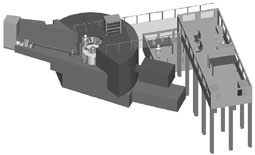 |
| The Wide-Angle Fermi Chopper Spectrometer is one of a class of “choppers” that will offer improved beam intensity of factors of 100. |
A researcher may want a highly specialized instrument for a particular analytical task, or a workhorse machine to perform basic studies. SNS will offer researchers a rich selection.
One example is the Backscattering Spectrometer, intended for studying atomic-scale dynamics at high resolution. It will provide data up to 100 times faster than existing instruments. Its optimal use is for probing the dynamics of atomic or molecular motion, which is very important in materials such as catalysts that have large surface areas.
The SNS will have two highly specialized reflectometers. The Magnetic Reflectometer is designed for studies of thin films, while the Liquids Reflectometer is designed to study surfaces affected by gravity (i.e., liquids). The SNS beam intensity will allow “off-specular” measurements—that is, measurements of molecular structures parallel as well as perpendicular to the surface—an added dimension.
The Extended Q-SANS Diffractometer will be able to cover in one measurement spatial scales from several hundred angstroms to a fraction of an angstrom. Small-angle scattering is in wide demand, and the Extended Q-Sans instrument, with its ability to analyze multiple scales at once, will be especially suitable for studying complex materials, particularly biological samples such as cell components. (Cells themselves are too large to be effectively studied with this instrument.) It will complement the new cold-source capabilities of ORNL’s High Flux Isotope Reactor.
| Some of the instruments will perform from 100 to several thousand times more effectively than instruments available now. |
Kent describes the Powder Diffractometer as a workhorse instrument—the world’s most flexible and versatile diffractometer. It will be very useful, he says, for studying small samples and performing parametric—or effect-over-time—experiments.
Those are machines that are funded for the SNS. The instrumentation group is also looking forward to adding several diffractometers to the selection. The Engineering Materials Diffractometer would be used to study engineering materials—particularly residual stress measurements—that are useful to the nuclear and other industries. ORNL has a rich background in using neutrons for residual stress measurements. Researchers will use the Ultra-High Pressure Diffractometer to study atomic structures at ultra-high pressures equal to those found deep in the earth or in brown-dwarf stars. A Disordered Materials Diffractometer would be used for small-angle studies of atomic structures of glasses and liquids, while the Single-Crystal Diffractometer would be optimized for rapid data collection from very small crystals and would enable study of the large number of materials for which it is impossible to grow large crystals.
Finally, SNS will have a class of spectrometers called “choppers,” so named because a mechanical device interrupts the neutron beam and allows only neutrons at a certain speed to reach the sample. The speed of the neutrons as they bounce back from the sample offers important clues about the materials. These chopper spectrometers will offer researchers enhanced sensitivity, broader ranges and improved intensity, in some cases by factors of approximately 100. They include the High-Resolution Fermi Chopper Spectrometer, which is optimized for single-crystal studies; the Wide-Angle Fermi Chopper Spectrometer, a lower-resolution instrument for wide-angle studies; and the 10-100 Microvolt Multi-Chopper Spectrometer, a very flexible and general-purpose analytical tool capable of sending up to 100 times more neutrons to the sample.—B.C.
 Some call it junk: Lab bears down on its legacy materials
Some call it junk: Lab bears down on its legacy materials |
| Old documents are legacy materials. |
“Legacy Materials” has a sinister ring to it, but the term can mean just about anything—from old office furniture, equipment and documents to chemicals and waste products.
“ORNL intends to renovate some of its older facilities, but that work can’t start until we’ve cleaned out all the junk,” says Karen Billingsley, who works with Dirk Van Hoesen and others in the Environmental Protection and Waste Services Division.
The Leadership Team has recently recognized the scope of the task of hand- characterizing and dispositioning the legacy materials that have accumulated over 60 years of research at ORNL. The LT has called on Lab organizations to clean up their work and storage spaces, as was recently highlighted in the August and September Safety 1st “Clean Up Your Work Space” initiatives.
The Legacy Materials Disposition effort isn’t simply a throw-out-the-baby-with-the-bathwater approach. Part of the process includes sorting through and characterizing the materials and deciding what’s worth keeping, what may have value, what can be reused and what should be tossed.
“The best outcome is to get 100-percent reuse of something,” Karen says. “My office is done in totally recycled furniture, for instance. But if something isn’t usable internally, it should be safely characterized, handled and disposed of through appropriate and economical channels that provide the best overall value for ORNL.”
In other words, outtahere.
Karen believes the seeds of ORNL’s waste problems were sewn in the project planning stages. Future projects, she says, should have a scheme, and the resources, for dealing with materials left in the aftermath of a project. In the past, the leftover equipment and documents would simply be stashed away and forgotten, only to become a problem years or decades later.
“There are better ways to do business. When we perform a project, we buy equipment and generate reports and papers. Then we go on to the next project. What happens, typically, is that no plans are made to dispose of those materials,” Karen says. “To make our work environment better, we need to have a plan, a budget and a place figured out for those leftover materials to go.”
Karen says several things drive the pack-rat compulsion. A piece of equipment may be hard to part with, even if it is unneeded, because it is expensive. The “government property” stamp also provokes reluctance to dispose of items, even if there are procedures for doing so. And if resources are tight, funds for dealing with the legacy materials might not be a priority.
Some also see the possible historical value of records and equipment as a reason for keeping them. Sometimes that’s the case. The EPWM Legacy Materials team is working with Team UT-Battelle and Friends of ORNL to identify items that might be of historical value (see articles, this page). At any rate, items forgotten and caked with dust have little historical value until they are retrieved.
Karen says the average staff member can take the initiative to help the Lab in its revitalization efforts.
“Take care of the easy stuff,” she says. “Get rid of old office furniture and papers that aren’t records. Reduce your stacks and piles. Check out our Website (eshtraining.ornl.gov/eshq/EPWS/EnvProg.html) for guidance on cleaning up your workspace.
“The difficult stuff—chemicals, old equipment, big items, hazardous materials, legacy waste—is what the Legacy Materials team can help you with. We also help integrate other services and resources—such as Lab Waste Services, Environmental Compliance, Property Sales and Records Management—when the decisions or handling of legacy materials aren’t simple.”
ORNL’s new facilities will have lots of new, empty space ready for science programs. The Lab’s older facilities can have lots of new empty space, as well, but it’s going to take considerable cleaning out.
“We need to think about how to best use our resources and how to get rid of items that we no longer need,” Karen says. “We can pick out the gems for reuse or historical value, but we have to clean up the Lab, prepare it for remodeling and make it a safer and better place to work.”—B.C.
 Lab comes through; tops this year’s United Way goal
Lab comes through; tops this year’s United Way goal |
| Events such as the apple- bobbing contest raised awareness for the ’02 United Way campaign and also raised money. Contestants were (from left) a submerged Kelly Beierschmitt, Bill Madia (with coach Susan Michaud) and ATLC’s Ed Mee. |
ORNL employees have topped the goal for the 2002 United Way campaign. In a year when traditional charities have run into tough competition for donations, Lab employees answered the call.
This year’s $630,000 United Way campaign goal was exceeded soon after the drive ended in August. At last count, this year’s drive had brought in around $650,000.
ORNL United Way Campaign chair Darryl Boykins expected the total to rise as late donations were tallied.
“Exceeding this goal reinforces what we know about the quality of individuals Oak Ridge National Laboratory comprises and their commitment to our communities,” says Darryl, associate Lab director for Human Resources and Diversity Programs. “This was truly a team effort by the campaign cabinet, solicitors, leadership givers, fundraising participants, the ATLC and, most importantly, our fellow employees and retirees who made a contribution to the fund.”
The Lab drive’s success comes at a time when events of the past year have diverted donations from traditional charities across the country. ORNL, however, has seen no negative numbers across organizations in this year’s campaign.
This year’s campaign featured a number of events, from an apple-cooking extravaganza to a putting contest. A silent auction raised more than $2,000. All combined, the events brought in the equivalent of about eight leadership givers—close to $8,000, according to campaign volunteer Nancy Gray.
Lab employees also volunteered for this year’s United Way “Day of Caring,” which coincided with the September 11 anniversary.
One year ago, Lab employees reacted to the 9/11 tragedy by donating nearly $25,000 for New York firefighters, a sum that included $10,000 from UT-Battelle. This spring, Lab employees again came through to contribute approximately $12,000 toward a $60,000 disaster-relief van for the local Red Cross. The special vehicle is expected to arrive this fall.
Those fund drives turned out to have little impact on the United Way drive. Darryl credits the continuing generosity of employees and retirees for carrying the load in this year’s United Way campaign. “Co-chair Greg Turner and I offer our sincerest thanks,” says Darryl.—B.C.
 Egami latest UT/ORNL Distinguished Scientist
Egami latest UT/ORNL Distinguished Scientist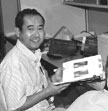 |
| Takeshi Egami at the High Flux Isotope Reactor during a 1999 visit. |
Takeshi Egami of the University of pennsylvania has officially accepted a University of Tennessee/ORNL Distinguished Scientist position. He plans to come to Tennessee next May.
Dr. Egami will do neutron scattering research in several materials-related areas. At ORNL, he will reside in the Metals and Ceramics Division. At UT, he’ll be part of the Materials Science and Engineering Department.
The new Distinguished Scientist is no stranger to ORNL; he has performed research with the High Flux Isotope Reactor in recent years.
Dr. Egami has also been named to receive the prestigious Bertram Eugene Warren Diffraction Physics Award from the American Crystallographic Association. The award recognizes an important recent contribution to the physics of solids or liquids using X-ray, neutron or electron diffraction techniques.

 New outlook for e-communication
New outlook for e-communicationThat news in itself could be as fear- and dread-provoking as replacing a comfortable old pair of shoes, but proponents of the switch say the move will provide much better service overall, especially with the many electronic communications products, such as palm-sized PCs, that we increasingly depend on. Those who have come to rely on electronic calendars to guide them through life stand to gain most from the change, says Karen Peacher of Com-puting Infrastructure Projects and Services.
As preparations for the change progress, CIPS plans to have brown-bag and possibly more formal training sessions to bring everyone up to speed. A committee has already been formed with representatives from ORNL organizations. Most features now enjoyed by Lab staff will still be offered, such as off-site e-mail access, Karen says. The one firm goal of the changeover team, she says, is that the transition be as smooth for the user community as possible.
The Oak Ridge e-mail user community experienced a significant change in September, unrelated to the Exchange/Outlook project. DOE employees across sites must now enter the entire mailnames or user IDs (complete with the domain suffixes, the part after @) if they are sending to parties at different contractors—y12.doe.gov and bechteljacobs.org. It’s part of the ever-increasing separation of the sites. Lab users who are e-mailing other ornl.gov users can still simply enter the mailname or three-letter userID.
 Nuisance e-mail: Learn to live with it
Nuisance e-mail: Learn to live with it
In our in-boxes and in discussions about e-mail, spam seems to always come up. Unsolicited e-mails from perfect strangers increasingly clutter up the networks, and some of it is hardly innocuous.
“Some studies have shown that up to 20 percent of all e-mail is spam and up to 33 percent of that amount is porn spam,” says Computer and Network Security’s Walter Dykas.
Other forms of spam include advertisements and shady business propositions, including umpteen versions of the famous and surely-by-now-threadbare Nigerian letter scam.
Exacerbating matters is the Klez virus, or worm, which hijacks address lists and sends out random e-mails and attachments. Some of these worms also have the ability to “spoof,” or send e-mails that appear to come from other, innocent, folks.
What can you do? Unfortunately, not much. There is one sure-fire remedy.
“Delete them,” says Walter.
 New buildings going up at full tilt
New buildings going up at full tilt
The private facilities construction continues to barrel along. The latest phase of the project is the raising of the walls—literally. In a method called “tilt-up walls,” the walls are built horizontally in forms on the ground and then lifted up into place by cranes.
The first wall went into place on Septem-ber 3. The rest will gradually be set into place all around the facilities. The building’s steel superstructure is attached to the walls once they are vertical.
The method isn’t new; the Romans raised walls that way. Tilt-up was first practiced commercially in California, where many seemingly crazy ideas are born, in the late 1950s. Wooden frames for houses are essentially put together and raised in the same way, except ORNL’s new walls weigh up to 85 tons.
Some of the many sidewalk observers have noticed that the brickwork that’s on some of the samples in Weinberg Auditorium isn’t readily visible on the walls. Engineering’s Gerry Palau explains not all the walls will have bricks. In the ones that do, the bricks are covered by protective trays and a wax coating, both of which will be removed. Plans are for tenants to start moving in by mid-2003.
|
|
|
|
| The
privately funded facilities’ walls are built flat on the ground (above) and raised by cranes. |
||
 ORNL power tech joins space race
ORNL power tech joins space race
An ORNL power technology could figure into future manned space missions. NASA announced recently that the ORNL-proposed Potassium Rankine Cycle Power Conversion System has been selected as one of the space agency’s Advanced Technology for Future In-Space Propulsion Applications.
Principal investigator Grady Yoder of the Nuclear Science and Technology Division explains that the system would convert thermal energy from a heat source aboard a spacecraft to electric power. Interplanetary spacecraft such as Voyager and Cassini rely on power from heat supplied by plutonium oxide. The Lab has been a central figure in the design and production of those Radioisotope Thermal Generator systems.
“The potassium rankine system would be more efficient and more lightweight than the thermoelectric converter technology used in the RTGs,” Grady says, “and would be used to produce significantly higher power levels.”
Such technologies hold the key to the feasibility of missions such as a manned flight to Mars. In fact, NASA’s announcement goes so far as to say, “Development of this technology will provide a giant step in capability for NASA to conduct future planetary missions, especially to the outer planets of Jupiter and beyond.”
The NSTD team will work with Boeing and Swales Aerospace on the three-year, $7 million project.
 New Mentor-Protégé Program helps small-business opportunities
New Mentor-Protégé Program helps small-business opportunitiesThe Mentor-Protégé Program fosters long-term business relationships with small business entities and provides increased opportunities and resources to enhance the firms’ capabilities to perform government contracts.
“ORNL has positioned itself to help and be helped at the same time. By mentoring a firm, ORNL will benefit by having a competent, highly skilled small business that can provide technical services in critical areas,” says Chief Financial Officer Greg Turner.
The program will also provide fundamental developmental assistance, which could involve technical and managerial coaching. The developmental assistance may enable the protégé firms to be more competent in their respective areas of business, in addition to developing a productive relationship with ORNL.
Summer interns Kimberly Hinton, a Tennessee State University graduate student, and Sindhu Zacharia, a University of Tennessee senior, helped implement the Mentor- Protégé Program and learned how important the success of small businesses is to ORNL. Both believe that the program will “serve as a vital link to the community by strengthening the economy and by providing opportunities for small businesses to prosper in mainstream America.”
Businesses that are eligible to participate in the program include small disadvantaged 8(a) firms, women-owned small businesses, historically black colleges and universities, other minority institutions of higher learning and small business concerns owned and operated by service-disabled veterans.
The restructuring of the program allows ORNL to serve as a mentor to more participants.
“The revised program will allow us to have more than one protégé. Streamlining made this possible,” said Will Minter, director of the Small Business Program Office.
The Small Business Program Office will coordinate the program and serve as point of contact. Other organizations that assist with the program include the University of Tennessee College of Business, which will serve as a mentor-protégé consultant, and the ORNL Procurement Organization, which will actively promote the protégé firms to all ORNL personnel. The Mentor-Protégé Program is a DOE initiative.
For additional information, visit www.ornl.gov/small business or contact Will, (865) 574-9803, e-mail minterwd@ornl.gov.
 ORNL People
ORNL PeopleThe September 16 issue of Physical Review Letters featured a paper titled “High-Beta Equilibria of Drift-Optimized Compact Stellarators,” which looks at high-beta quasipoloidal stellarator-type configurations. The paper’s first author is Andrew Ware from the University of Montana-Missoula, an ORNL university collaborator. ORNL co-authors are S.P. Hirshman, D.A. Spong, L.A. Berry, and J.F. Lyon.
The Environmental Sciences Division’s Bonnie Lu has been named an “unsung hero” by the Organization of Chinese Americans. She received the 2002 OCA/General Motors volunteer award at the OCA’s convention in July. Bonnie is a charter member of the local OCA chapter and has held several different positions on the board of directors. She was instrumental in the Oak Ridge chapter’s recognition for outstanding growth and has been active in the Lab’s Asian Pacific Heritage Month celebration. She also worked with others on a 9/11 fundraising project last year that raised $5,000 for New York firemen.
 OVER A BARREL
OVER A BARREL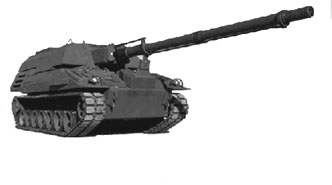 |
| ORNL’s Infrared Processing Center may hold solution to a wearing battlefield problem |
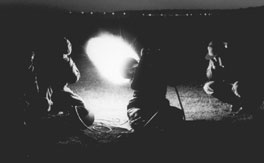 |
| The Army wants to put samples of ORNL’s infrared-processed gun barrels through torture tests to ensure they will perform as expected. |
Gun barrel failure is a loaded problem that ORNL researchers hope to solve with a powerful flash of infrared light.
Guns and heavy artillery weapons can damage themselves as well as their targets. Normal wear from projectiles propellants, and combustion gases causes fatigue and erosion in conventional gun barrel materials, leading to cracks and material loss that can render a weapon useless. More energetic propellants developed by the U.S. Army for future combat systems can wear down a gun barrel to an unusable state in as few as four to five rounds.
“In the middle of combat you can’t say, ‘Hold on, I’ve got to change barrels,’” says Bill Corwin, Defense Materials program manager in ORNL’s Metals and Ceramics Division. “This is a problem that needs to be solved.”
Using the 300,000-watt plasma arc lamp in ORNL’s Infrared Processing Center, Laboratory researchers hope to metallurgically bond, or “weld,” a metallic coating to gun barrel steel to demonstrate that the barrel can be made more resistant to fatigue and erosion, extending its life. The advantage of metallurgical bonding over mechanical bonding in coated metals is that the strength of the bonds between the atoms of the coating and substrate is greatly enhanced, reducing the likelihood of coating failure.
Infrared light from the world’s most powerful type of radiant lamp at ORNL can be focused to scan a metal sample being coated. Heat is added so quickly that only the top surface layer of the substrate is affected. Thus, metals with high melting points, such as refractory metals, can be used to coat metals of lower melting points, such as steel, hardening them without altering their bulk structure and properties. The refractory metal molyb-denum-41 rhenium is a top candidate for gun barrel coatings because it has shown more resistance to thermal shock and erosion in tests than other candidate materials, Bill says.
Gun barrels are traditionally made from a variant of 4340 steel protected inside by a mechanically bonded hard-chrome coating. However, the chrome coating presents two problems: it is a known carcinogen and it does not completely protect the barrel from fatigue and erosion because the coating is plated—mechanically rather than metallurgically bonded—to the bore of the barrel.
Applying a noncarcinogenic coating that is metallurgically bonded associated with the substrate would eliminate the problems of the chrome coating. Such a strong, uniform coating would prevent cracking and erosion in the barrel.
With today’s technologies, metallurgically bonded coatings can only be applied to gun barrels with heat. Already, however, the steel used in the barrel is heat treated to give it the high strength and hardness needed in a weapon.
Unfortunately, then, applying heat to coat the steel produces a “heat affected zone” (HAZ) that reduces the hardness and heat resistance of the steel. The weakened steel thus becomes more prone to fatigue and cracking after repeated firings.
The extremely high heating rates of infrared processing can limit the depth of the HAZ to less than that produced in normal gun firing. Hence the strength of the gun barrel can be maintained.
Instead of applying heat, the Army is looking at a sputtering method for depositing a layer of tantalum inside gun barrels. However, the tantalum layer applied by sputtering is only mechanically bonded, so it may be subject to spalling (peeling off) when a fatigue crack occurs. Another drawback is that tantalum is porous to hydrogen, a by-product of combustion. As a result, the barrel steel is exposed to the hydrogen, which can make the barrel brittle and more susceptible to fatigue and cracking.
“The ideal gun barrel would be made of steel metallurgically bonded to a refractory metal coating that is not porous to hydrogen and that does not create a greater HAZ than is produced during routine firing,” says Bill. “Our solution to this problem is to coat the steel with moly-41 rhenium using our infrared lamp.”
M&C staff members recently proposed the idea of using ORNL’s infrared process to coat gun barrels to officials at Benet Laboratories at Watervliet Arsenal, an Army facility in New York. Army officials there thought the idea interesting but declined to fund the research until ORNL provides coated samples that the Army can put through its “torture test” to ensure they will perform as expected.
Bill and others in this group are seeking funding to make test samples for the Army. If the samples pass the test, it is hoped that the Army will provide research funding for large-scale experiments for gun barrel coating at ORNL’s Infrared Processing Center.
ORNL researchers would like a shot at helping the Army improve gun barrels for future combat weapons.—Jodi Lockaby
 Wisdom of years
Wisdom of years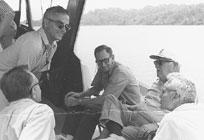 |
| FORNL volunteer Josh Johnson brought in this rare photo of the late Rep. Chet Holifield (second from right) on a visit to Oak Ridge. Among those who took him on a boat ride were ORNL Director Emeritus Alvin Weinberg (far right) and former Lab researcher Phil Hammond (upper left). |
Just like an old family album, the ORNL historical photo collection has pictures of just who and what, no one is quite sure. The Lab is currently banking on the help of a group of Friends of ORNL volunteers to identify old photos to help determine their significance.
It’s only one of the services the Friends of ORNL perform for the Lab, from hosting a terrific community lecture series to guiding the Lab’s popular public tours. FORNL President Dave Reichle wants everyone to know that FORNL is open to all Lab supporters of all ages.
“This isn’t just a retirees organization,” Dave says. “We want current employees and citizens who are concerned about ORNL’s future and support what it does.”
To be sure, many of the Friends are Lab veterans—some going back to the Lab’s earliest days, who represent a treasure trove of historical and institutional knowledge. The photo project, which has been going on over the summer, has been a joint FORNL and Team UT-Battelle effort to tap that knowledge to better chart the Lab’s pictorial history.
| FORNL is open to everyone. |
Jerry Slaughter, John Bigelow, Josh Johnson, John Griess, Fred Maienschein and Harold Smith have volunteered numerous hours already in going through folders of photos in Lab Records. Once identified, information on the photos is stored on the Lab’s digital photo archive, the Image Retrieval and Information System.
One photo that’s surfaced is a rare picture of a visit by the late Rep. Chet Holifield, an early supporter of national labs in Congress who has a namesake facility at the Lab—the Holifield Radioactive Ion Beam Facility. In the 1980s, ORNL was briefly named for him.
The Lab also welcomes historically significant photos from personal collections. If you are interested in volunteering time to identify photos, call Debbie Dickerson, 574-4160, or Marilyn McLaughlin, 574-4163, and they will arrange for you to come out to the Lab.
Anyone interested in joining is welcome. Contact FORNL Treasurer Joe McGrory by e-mailing him at emcgroy@comcast.net, or write him at 205 Connors Circle, Oak Ridge, TN 37830. They meet every third Wednesday of the month for lunch and a program at the Oak Ridge Civic Center.—B.C.
 Team UT-Battelle volunteers join state’s whooping crane recovery effort
Team UT-Battelle volunteers join state’s whooping crane recovery effortThe efforts for the cranes include a fundraiser—a walk-a-thon October 10–19.
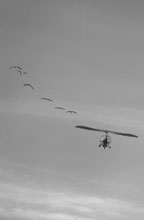 |
| Rare whooping cranes follow an ultralight aircraft. It’s been demonstrated that the planes can help the birds re-establish migratory routes. |
The walk, on a route that follows the birds’ planned migration route over Tennessee from the Kentucky state line to Chattanooga, will feature a “symbolic whooping crane” being passed from one walker to another. Proceeds from the event will go to the Tennessee Wildlife Resources Foundation and the Whooping Crane Eastern Partnership. Funds designated for the TWRF will be used for an educational outreach program, habitat enhancement and a new education facility currently under construction at the Hiwassee Refuge in Meigs County.
Migrating whooping cranes—one of the nation’s more famous endangered species—haven’t been seen in the skies in more than a century. In the 1940s the known population dwindled to 16, the result of unrestricted hunting, loss of habitat and other pressures on the species.
Populations have been reestablished, but they are nonmigratory. It’s been demonstrated that ultralight aircraft can actually help the birds re-establish their migratory patterns by leading the way over safe migratory routes.
UT-Battelle participants should contact
Lynn Wright (wrightll@ornl.gov) or Janet Cushman (cushmanjh@ornl.gov) for more information. Either Lynn or Janet is available to give luncheon talks about the effort and present a 20-minute tape that explains how the whooping cranes have been trained to follow the ultralight planes.
General information about whooping cranes and specific information about registering for the walk-a-thon or donating to the effort can be found on the Web at www.whoopingcranesovertn.org.—B.C.
 Hidden disabilities theme of awareness month
Hidden disabilities theme of awareness monthThat sort of triumph over adversity can be a double-edged sword. Sometimes an apparently fit and able person draws disapproving glances by parking in a spot reserved for handicapped people. Debra Dickerson, secretary for Communications and Community Outreach, knows that uncomfortable feeling.
“I have MS (multiple sclerosis) and I have a permit that allows me to park near my office. On most days you wouldn’t know I have MS and I don’t park inside. But I have to use my permit on those other days,” she says.
ORNL’s Disability Awareness Month theme focuses on hidden disabilities and explores ways the work place can be adapted to help those who must cope with them. The committee has several awareness events planned for October, including a panel discussion, set for October 29, by ORNL staff members who have hidden disabilities.
Toward the “New Freedom for the 21st Century” national theme, on October 23 a representative from East Tennessee Access Center will demonstrate various toys and other objects that engineers in the area have adapted to make them user friendly for disabled children and adults. Former Lab employee Larry Bohanon will demonstrate his Quadriciser.
President Bush’s New Freedom initiative is aimed at increasing access to assist technologies, expanding educational opportunities and increasing the ability of Americans with disabilities to integrate into the work force.
Activities at the Lab also include an appearance on October 8 by Chef Jock, a local chef and television personality who was paralyzed in a car accident last year.
Disability Awareness Committee members are Scott Branham, Mylissa Buttram, Linda Croff, Debra Dickerson, Ed Fadden, Teresa Ferguson, Teresa Honeycutt, Sue Human, Saylor Hummel and Nancy Wright.
 Softball champs dedicated season to late coach
Softball champs dedicated season to late coach
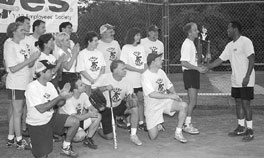 |
| Stonefinger captain Ted Kaplan and teammates accept the YES tournament trophy from Pete McKenzie (right). |
Stonefinger captain Ted Kaplan says the team dedicated its season to its late player-coach, Mark Mostoller, who died earlier this year. Mostoller was a former coworker in the Solid State Division and was a motivator in what was once a thriving recreational league softball scene among DOE contractors and subcontractors. Players from the old team formed the core of this year’s championship team.
“Softball used to be huge several years ago,” says Ted. “The Stonefingers go back 24 years, all the way back to Union Carbide.”
The shift to multiple contractors and other changes caused the rec league to wane.
“It used to be a big deal. A lot of us still miss it,” says Ted.
Sufficient interest remained for the Y-12 Employee Society to form a four-team softball league this summer. Enough veterans of the largely Ph.D.-comprised Stonefingers team were game, augmented by some new players.
“We got some younger folks,” Ted says. “Not ringers. Just people who can bend over and pick up grounders.”
The Stonefingers adorned their game shirtsleeves with Mostoller’s name. Those who took part in the early Stonefingers say “Mad Dog” Mostoller was more than a coach. “He was well-loved for his caring and populist philosophy and revered for his uncanny ability to write about baseball with wit and humor,” says Honors and Awards coordinator and softball fan Phil King. “He was—and is—a kind of icon in the communities in which he moved and lived.”
YES sports committee chair Pete McKenzie, a BWXT/Y-12 employee, says the society will announce a new softball season next January, to play ball in April. Other activities, which will also be open to DOE contractors and subcontractors, include a golf tournament this fall and volleyball. Watch ORNL Today for details.
Team members are Ted, Lenny Gray, Greg Hinkel, Dave Mandrus, Peter Khalifah, Brian Sales, Ray Zuhr, Lexi Pierce, Joanne Ramey, Lenora McBee, Pam Fleming, Lynn Smalley, Tony Haynes, John Pierce, Fred Bullock and John Budai.
The Stonefingers intend to build on their progress. “We got stronger as the year went on,” says Ted. “It turned out to be a lot of fun.”—B.C.
ORNL office: P.O. Box 2008, Oak Ridge, TN 37831-6146, Building 4500-S, Room F-60, MS 6146
ORNL help line (ethics; fraud, waste and abuse; quality; ES&H)
576-9000
[an error occurred while processing this directive]
[an error occurred while processing this directive]
Bill Cabage, lead editor, ORNL, 574-4399 (cabagewh@ornl.gov)
Deborah Barnes, associate editor, 576-0470 (barnesds@ornl.gov)
Ombudsman: 576-7802
DOE inspector general hotline: 1-800-541-1625